![]()
![]()
![]()
Use LEFT and RIGHT arrow keys to navigate between flashcards;
Use UP and DOWN arrow keys to flip the card;
H to show hint;
A reads text to speech;
8 Cards in this Set
- Front
- Back
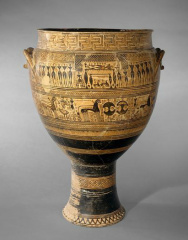
|
Terracotta krater ca. 750-735 B.C. Geometric Greek, Attic Funeral Krater, Human/animal representation abstracted. Levels organized into registers, depicts scene of war and of death/display of dead. Wants you to know 2 things: warrior, Heroic. Mourned by relatives/family |
|
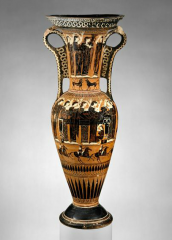
|
Terracotta loutrophoros (ceremonial vase for water)view #1 Date: late 6th century B.C. Archaic H. 27 3/4 in. (70.5 cm) |
|
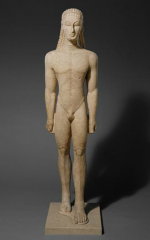
|
Marble statue of a kouros (youth) Marble, Naxian ca. 590-580 B.C. Archaic Probably grave marker for individual, same stiff position as Egyptian figure. Slightly more muscly/naturalized, but still idealized, basic abstract lines. Nude - Greeks were unique in this, nudity as sign of athletic prowess. Technical advancement, figure released from stone |
|

|
Marble stele (grave marker) of a youth and a little girl Marble ca. 530 B.C. Archaic Standard format: Greeks interested in memorializing types, not individuals. Cap: sphinx, guardian of the dead. Note Archaic smile same pose and stiffness, but not very 3D |
|
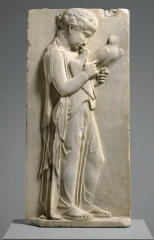
|
Marble grave stele of a little girl (with doves) Marble, Parian Classical ca. 450-440 B.C. Emerging classical style - full lips and chin, distant, peaceful look Transition in style: drapery beginning to belie body beneath, body starting to unstiffen: naturalistic |
|

|
Marble stele (grave marker) of a woman Marble Late Classical mid-4th century B.C. Tilted head, bent/fluid limbs face more expressive, lips open volume to body - drapery pulls around to define body beneath |
|
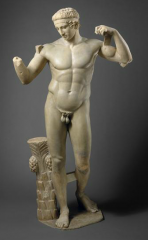
|
Fragments of a marble statue of the Diadoumenos (youth tying a fillet around his head) Marble Early Imperial, Flavian ca. A.D. 69-96 Both works we looked at Roman copies of Greek original (bronze) statue by Polykletos Polykletos inventor of the Canon system of proportions - rationalism in art Idealized naturalism, he is an athlete but could be a god Contro Posto pose - all weight of body rests on one leg, creates corresponding S curve of body No longer simplistic V torso, muscular, undulates; meant to be viewed in naturalistic light |
|

|
Polykleitos, head of a youth |

